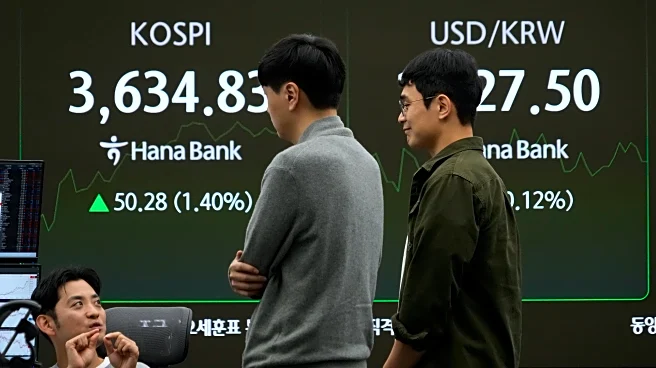What's Happening?
The U.S. Treasury market has maintained stable yields, contrary to the expectations of debasement trade promoters who anticipated a rapid decline in the U.S. dollar's value. The 10-year Treasury yield has recently dropped to a one-month low of 4.017%, indicating that the bond market does not foresee a significant debasement of the dollar. This stability in yields is reflected across various segments of the bond market, including the $29-trillion Treasury market, the $11-trillion corporate bond market, and the $9-trillion residential mortgage-backed securities market. Despite predictions of currency debasement, the bond market has taken a contrary position, betting on cooling inflation and stable yields.
Why It's Important?
The stability in U.S. Treasury yields suggests confidence in the dollar's value and the broader U.S. economy. This contradicts the debasement trade narrative, which posits that government borrowing and money printing will erode the dollar's value, driving investors towards assets like cryptocurrencies, gold, and silver. The bond market's stance indicates a belief in manageable inflation levels and a stable economic outlook, which could reassure investors and policymakers. The implications are significant for financial markets, as stable yields can influence investment strategies and economic forecasts.
What's Next?
If the bond market continues to defy debasement trade expectations, it could lead to a reassessment of investment strategies focused on alternative assets. Investors may need to reconsider their positions in cryptocurrencies and precious metals if the dollar remains stable. Additionally, policymakers might focus on maintaining economic stability to support the bond market's confidence. Future economic data releases and Federal Reserve policy decisions will be closely watched for indications of inflation trends and monetary policy adjustments.
Beyond the Headlines
The bond market's resistance to debasement trade pressures highlights the complex dynamics of global finance, where narratives can diverge from market realities. This situation underscores the importance of understanding market signals and the potential disconnect between speculative trading themes and actual economic conditions. The bond market's stability may also reflect broader confidence in U.S. fiscal and monetary policies, suggesting a resilient economic framework despite global uncertainties.












